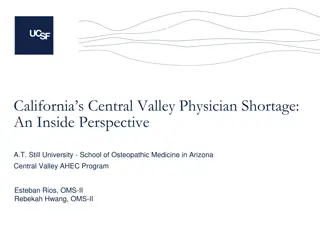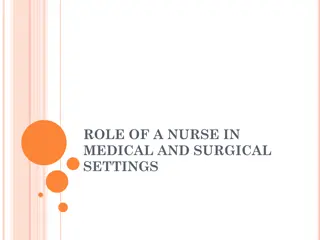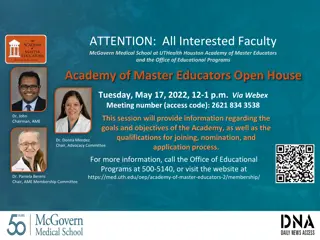Role of Supervising Physicians in Medical Education: A Guide for Educators
Ensuring the development of future physicians is vital, especially during challenging times like the COVID-19 pandemic. This guide emphasizes the importance of supervising physicians as educators at the University of Cincinnati College of Medicine. It covers the essential roles of supervisors, role models, teachers, and evaluators, along with guidelines for coronavirus precautions to be followed by medical students. The content highlights the significance of attending physicians and residents/fellows as teachers, focusing on passing on wisdom, professional responsibility, and mutual learning opportunities.
Download Presentation

Please find below an Image/Link to download the presentation.
The content on the website is provided AS IS for your information and personal use only. It may not be sold, licensed, or shared on other websites without obtaining consent from the author. Download presentation by click this link. If you encounter any issues during the download, it is possible that the publisher has removed the file from their server.
E N D
Presentation Transcript
Supervising Medical Students: Your Role as an Educator The University of Cincinnati College of Medicine
First, Thank You! for teaching our medical students. They are the future of medicine, both for our patients and for us. They will care for our loved ones, and your role as physician educator is crucial for their development. During these critical times, our community partners are even more crucial to the future of medicine and we thank you!
Outline Medical education during COVID-19 Rationale for residents and other supervising physicians as teachers UCCOM curriculum and key contacts Four primary roles of supervising physicians as supervisors, role models, teachers, and evaluators UCCOM policies
Coronavirus Precautions For UCCOM/VSLO students, the expectation is to follow the CDC guidelines and institutional guidance of the student s clinical site for COVID-19. CDC Guidelines for Isolation and Precautions FOR UC HEALTH: Please follow the link provided to find out the procedure in the following situations: 1) If you are experiencing ANY respiratory symptoms. 2) If you have received a positive COVID test result. 3) If you have been in contact with someone who has COVID. UC Health Guidelines for COVID-19 Symptoms/Exposure and Returning To Work FOR CCHMC: Call 803-SAFE for initial testing and all return to work NOTE: Students must facilitate their own testing but can find additional testing resources at the following page www.uc.edu/publichealth If there are any questions, students are welcome to contact Deana Brown (Deana.Brown@uchealth.com).
Supervising Physicians and Residents are Key to Medical Education College of Medicine
Rationale for Attending Physicians as Teachers The passing of wisdom during experience The 30,000 foot view of medicine, whereas earlier learners might be learning more ground level More experience over time in supervising trainees of different levels (e.g. student, resident, fellow) Teaching is our professional responsibility Teaching can aid our own learning
Rationale for Residents/Fellows as Teachers Residents have the most contact with students Increased opportunity to observe the students and to be observed by the students Can still relate to the ground level and connect to the 30,000 foot view Opportunity to develop teaching and evaluation skills Teaching is our professional responsibility Teaching can aid our own learning
Four Primary Roles for Supervising Physicians in Medical Education Supervisor Role model Teacher Evaluator In order to do this, you need to know about our curriculum.
Cincinnati Medicine Curriculum Overview Competencies Curriculum and Timeline M3/4 Requirements Clinical Clerkships Student Learning Outcomes
Cincinnati Medicine Program Competencies Competency Competency Description Provide patient-centered care that is compassionate, appropriate, and effective for the treatment of health problems and the promotion of health. Patient Care Demonstrate knowledge of established and evolving biomedical, clinical, epidemiological and social-behavioral sciences, as well as the application of this knowledge to patient care. Knowledge for Practice Demonstrate the ability to investigate and evaluate one s care of patients, to appraise and assimilate scientific evidence, and to continuously improve patient care based on constant self-evaluation and life-long learning. Practice-Based Learning and Improvement Interpersonal and Communication Skills Demonstrate interpersonal and communication skills that result in the effective exchange of information and collaboration with patients, their families, and health professionals. Demonstrate a commitment to carrying out professional responsibilities and an adherence to ethical principles. Professionalism Demonstrate an awareness of and responsiveness to the larger context and system of health care, as well as the ability to call effectively on other resources in the system to provide optimal health care. Systems-Based Practice Interprofessional Collaboration Demonstrate the ability to engage in an interprofessional team in a manner that optimizes safe, effective patient- and population-centered care. Personal and Professional Development Demonstrate the qualities required to sustain lifelong personal and professional growth. *Note these are the domains of the AAMC Physician Competency Reference Set (and slightly different than the 6 ACGME core competencies).
Cincinnati Medicine M1/2 Requirements M2 YEAR Requirements Foundational Courses 1. Cardiovascular and Pulmonary 2. Renal and Gastrointestinal 3. Physician and Society 4. Endocrine and Reproductive 5. Multi-Systems M1 YEAR Requirements Foundational Courses 1. Fundamentals of Molecular and Cellular Medicine 2. Physician and Society 3. Musculoskeletal/Integumentary 4. Nervous System 5. Blood System Clinical Experiences Healthcare Emergency Management II Clinical Skills (CS) Fundamentals of Doctoring (FOD) Clinical Experiences Healthcare Emergency Management I Clinical Skills (CS) Fundamentals of Doctoring (FOD)
2024-25 M3 Clerkships and M3 Electives Family Medicine (4 weeks total) Pediatrics (8 weeks total) 4 weeks outpatient 4 weeks inpatient, 4 weeks outpatient Internal Medicine (8 weeks total) Psychiatry (6 weeks total) 4 weeks inpatient, 4 weeks outpatient Two 3-week experiences Neuroscience (4 weeks total) Surgery (8 weeks total) Two 2-week experiences 4 weeks core surgery, 4 weeks specialty Obstetrics & Gynecology (6 weeks total) 2 weeks GYN surgery, 2 weeks L&D, 2 weeks outpatient Specialty Electives/Clerkships (two, 2-week experiences)* Students must choose 2 of the following: Anesthesiology, Cardiovascular ICU, Clinical Oncology, Dermatology, Emergency Medicine, Geriatrics, MICU, Ophthalmology, Otolaryngology, Pathology, Radiology, Urology *Exposure (2 weeks) that is pass/fail (as opposed to an intensive experience); exception is Ophthalmology which is graded using Honors/High Pass/Pass categories. https://med.uc.edu/education/medical-student- education/office-of-medical-education/integrated- curriculum/m3-integrated-clinical-clerkships Use this hyperlink to find more information about M3 rotations
Third Year Core Clinical Clerkships Student Learning Outcomes 1. Gather appropriate and accurate patient history. 2. Perform appropriate patient exam for the presenting problem/reason for visit. 3. Generate an appropriate problem-based differential diagnosis and plan. 4. Follow through on the appropriate diagnostic and therapeutic action plan. 5. Communicate patient information to the clinical team in oral form. 6. Communicate patient information to the clinical team in written form. 7. Communicate effectively with patients of diverse backgrounds (e.g. age, gender, social, racial, and economic backgrounds). 8. Demonstrate a commitment to self-directed learning by developing your knowledge outside of the traditional learning environment (e.g. demonstrate ability to retrieve and cite evidence from reliable references to advance patient care) 9. Collaborate with an interprofessional health care team (i.e. communicate with nurses, respiratory therapist, social workers, pharmacist, primary care physician, etc.). 10. Demonstrate professional behavior in clinical setting (e.g. appearance, reliability, punctuality, motivation, commitment, and respect). The core clerkship outcomes are aligned with the Entrustable Professional Activities (EPAs) as defined by AAMC.
Cincinnati Medicine M4 Requirements M4 YEAR Requirements 4 weeks Internal Medicine (IM) Acting Internship (AI) 4 weeks Specialty AI in other specialty of choice 12 weeks of Intensive Clinical Experience (ICE) Minimum expectation of 20 hrs/week of direct patient care 12 weeks of general electives _________________________________________ 32 weeks total
Fourth Year Required Internal Medicine AI Learning Outcomes 1. Write admission orders. 2. Answer a nurse call. 3. Write a discharge summary. 4. Write a cross-cover note. 5. Give and receive patient handoffs (both in writing and verbally) to transition care responsibly. 6. Speak with specialist/subspecialist colleagues to request consultation. 7. Negotiate conflict with colleagues. 8. Deliver bad news. 9. Discuss an adverse event with a patient. 10. Obtain informed consent. 11. Gain familiarity with obtaining advanced directives and documenting DNR. 12. Review pronouncing death and filling out a death certificate.
Dates and Timeline Pay attention to rotation dates to help students transition to new rotations and met goals before finishing rotations Click here for M3 Dates Click here for M4 Dates Pay attention to timing of educational conferences and other demands on students Pay attention to clerkship assessments High stakes end of clerkship NBME subject exam (shelf) OSCE testing
Key Contacts for the M3/4 Curriculum College of Medicine
Clerkships and Clerkship Administration Know the Clerkship Director and Clerkship Coordinator first and foremost Clerkship Director / Clerkship Coordinator Clerkship Dr. Sarah Pickle/ Nancy Jamison Family Medicine Dr. LeAnn Coberly / Gabriela Ionascu Internal Medicine Dr. Starla Wise / Angela Bustamante Neuroscience Dr. Jane Morris / Natalie Cassady Obstetrics & Gynecology Dr. Corinne Lehmann / Mimi Pence Pediatrics Dr. Peirce Johnston / Sonya Kirkland Psychiatry Dr. Latifa Silski / Nikki Norman Surgery Click here for contact list! Use this hyperlink to find more information about clerkship administration and contact information https://med.uc.edu/education/medical-student- education/office-of-medical-education/integrated- curriculum/m3-integrated-clinical-clerkships
Cincinnati Medicine Administrative Team Offices of Medical Student Affairs Office of Medical Education (OME) Student Affairs: Provides academic support, coordination of academic schedules, advising, financial services, and student wellness activities. Provides central coordination of the curriculum and ensures all operational matters of the academic programs are compliant with accreditation standards. https://med.uc.edu/education/medical-student- education/office-of-medical-education/home https://med.uc.edu/education/medical-student- education/student-affairs Associate Deans: Dr. Pamela Baker Dr. Bruce Giffin Associate Dean: Dr. Dawn Bragg Assistant Dean: Dr. Laura Malosh Career Development Director: Dr. Alice Mills Director of Financial Services: John Stiles Registrar: Kristy Wilson Assistant Dean: Dr. Laurah Lukin Director of Medical Education: Dr. Tracy Pritchard M1/2 Curriculum Director: Dr. Stephen Baxter M3/4 Curriculum Director: Dr. Danielle Weber M3/4 Program Director: Gina Burg Director of Electives: Dr. Amy Guiot
Cincinnati Medicine Administrative Team Office of Medical Student Admissions and Special Programs Office of Diversity, Equity & Inclusion Supports an inclusive environment for all and welcomes diversity in every aspect of daily operations. https://med.uc.edu/admissions/medical-student- admissions https://med.uc.edu/diversity/home Admissions: Oversees the selection process of medical students. Assistant Dean: Dr. Bi Awosika Associate Dean: Dr. Donald Batisky Learning Specialist: Dr. Swati Pandya
Role of Supervising Physicians College of Medicine
Supervising Medical Students Ideally students are directly participating in patient care as much as possible. What this looks like and amount of supervision required may vary based on setting or specific student. Participating in patient encounters includes: Acting as the patient s caregiver (with appropriate supervision), including ongoing management of hospitalized patients Aiding in complete or problem focused history and physical Aiding in diagnostic and therapeutic plan
Supervising Medical Students Observation in patient encounters implies no direct patient contact (e.g. taking a history or performing a physical, participating in diagnostic/therapeutic plan) Try to minimize pure observation as students learn best by participating in patient care Observation can be powerful teaching tool though, when used intentionally Have students observe a physical exam maneuver new to them or a procedure they have never done Have students observe difficult conversations or discussions outside their scope (e.g. obtaining consent) Encourage students to observe another care provider (e.g. consultant provider, allied health professional, etc)
Supervising Medical Students Assign patients and tasks to promote student s learning and to integrate them into team Assure adequate supervision of students as they provide patient care, including performing procedures and examinations Consider whether direct or indirect supervision is appropriate If indirect supervision, need to double check everything Students may not accompany monitored patients off the floor Co-sign notes or write agree with notes within 24 hours. Ask your educational team about your own documentation rules with med student notes. Co-sign orders (when appropriate)
Physicians as Role Models College of Medicine
You are a Role Model Students see everything you do. You are role modeling through your behaviors and actions even when you do not think you are. This can be more powerful than the explicit curriculum taught Be aware of: Comments in the presence of students who may not fully appreciate the difference between venting to colleagues and disparaging patients Discussions with colleagues who are also friends in the presence of students, what you say to friends may not be appropriate to say in a work environment or around students Be aware of and prepared to respond to microaggressions in the learning environment
You are a Role Model We expect you to role model the professional attributes that medical students are expected to develop: Duty Integrity Respect Honesty Compassion Fidelity Dependability You are expected to maintain a positive learning environment for all our medical students The learning environment impacts students in many ways, including their view of you and your specialty
Physicians as Teachers College of Medicine
Role as a Teacher Create a positive learning environment Involve student and show they are valued (know their name and use it, ask them what their goals are and areas they wish to improve) Be approachable (open to answering questions, elicit their questions) Create psychological safety Key is to create a non-threatening atmosphere where they feel open sharing their uncertainties, mistakes, confusion, etc. Make it known you are interested in helping them get better and be the best physician they can be. You can have psychological safety and still have high expectations and accountability! This is actually the recipe for learning and growth!
Role as a Teacher Find teachable moments throughout the day Connect teaching to a patient as much as possible Help students develop their thought process by Thinking Out Loud or sharing reason behind decisions Ask students to apply information to a new patient or different scenario Go to the bedside together Help students prepare to evaluate a patient (what history and/or exam items are important to obtain for the CC) Observe students (direct supervision) and provide feedback Demonstrate/teach a skill (can exam a patient together, have them observe you but tell them what they are observing and why) Get paged to evaluate a patient? Take them with you and tell them what you are thinking.
Role as a Teacher Think about the level of the learner What do they already know? What do they need help with? Explore this so you can focus teaching points to help them reach next level (concept of zone of proximal development) Help students learn to adapt their history taking and physical exam to different contexts or more complicated cases Help students learn how to organizing information for presentations and notes Facilitate students developing clinical reasoning skills Help them develop frameworks for their clinical reasoning (e.g. approach to a patient with abdominal pain) Help them understand how to prioritize different pieces of information (e.g. normal heart exam does not rule out cardiac pathology)
Role as a Teacher Personalize learning when possible What do they want to learn? What specialty are they interested in? Explore this and then provide relevant teaching pearls, give related chalk talks, or assign readings. Example: could focus on pre-surgical evaluations for a student going into orthopedics on IM rotation Promote self-directed learning and give feedback on that learning Encourage goal setting and help student set specific goals Encourage looking things up and discussion of scholarly articles
Physicians as Evaluators College of Medicine
Role as an Evaluator Set expectations for performance This is harder than you think but crucial What determines meeting expectations vs exceeding expectations? Provide specific, actionable, and timely feedback Ask students what their goals are or areas they are working on, then give feedback related to this Feedback immediately after a student evaluates a patient or presents on rounds, for example, can be very helpful Try to give feedback each day and ongoing feedback throughout your time together Do not avoid constructive (or critical feedback). This is important to give, just think about delivery.
Mechanisms for Formative Feedback for M3 Students Supervising physicians can provide formative feedback to students electronically using a unique QR code provided to each student. This data will be populated to create individual dashboards for students to track their personal growth based on feedback they receive FORMATIVE FEEDBACK DOES NOT CONTRIBUTE TO STUDENT GRADES
Providing Formative Feedback Give it a try: Scan the QR code to view the form. Note: Android users will need to download barcode scanner.
When you scan the QR code, you will see short assessments that include Likert items and a comment box for narrative feedback for that clerkship (see sample screenshots below) These items and narrative feedback are mapped back to the UCCOM program objectives
Preceptor Summative Evaluation for Students The preceptor evaluation is a summative evaluation worth 50%* of the student s grade on a clerkship. *55% in internal medicine There are two broad categories on the Preceptor Evaluation to assess student performance: Clinical Performance Teamwork and Self-Improvement Skills Weighting of Preceptor Summative Evaluation Scoring 90% for items falling under Clinical Performance 10% for items falling under Teamwork and Self-Improvement Skills Click here to view or download a sample evaluation form. Note that evaluations will vary by clerkship. M3 Form M4 Form
Preceptor Summative Evaluation for Students Please keep these primary goals in mind in the assessment you provide: Assess the students performance based upon the task rating scale The task rating scale is based on what you would expect of a student at that level (i.e. an M3 student or an M4 student) Most students should not receive the same rating for every item. Most students should not receive the highest rating. Mark did not observe if you are unable to adequately assess an item Write narrative feedback that is specific and based on description of behaviors Click here to view a short video explaining how to think about the evaluation: https://uc.mediaspace.kaltura.com/media/New+Preceptor+Evaluation- +Information+for+preceptors/1_rvkiabqk
Preceptor Summative Evaluation for Students Please provide thoughtful, specific narrative comments Avoid comments like read more or will develop this with time Good narrative comments are important for: Students to reflect and guide continued growth Students to understand their evaluation Creating the MSPE (i.e. Dean s letter) Please write narrative comments that reflect how you assessed the student s performance as this is helpful to students and the clerkship/course director Note, there is an area to provide comments that do not go in the students MSPE (i.e. Dean s letter)
Policy on the Assessment of Student Performance by Faculty Healthcare Providers All faculty members must recuse themselves from any role in assessment, evaluation, or grading of any medical student for whom they have provided healthcare services. If assigned to assess/evaluate/ grade a student for whom a faculty has provided care, the faculty must notify the course or clerkship director as soon as is possible, of the need for reassignment and must indicate on any related evaluation forms that he/she must recuse themselves from evaluating that student. For full policy, click here.
Professional Development Opportunities in Teaching and Assessment There are a variety of offerings each month through the College of Medicine Office of Faculty Affairs and Development. To view upcoming workshops, go to: https://med.uc.edu/about/admin- offices/faculty/development
Cincinnati Medicine Policies College of Medicine
KEY Cincinnati Medicine Policies and Procedures Click on the policy names below to view the entire policy. Principles Guiding Interactions Between Teachers and Learners in Medicine Duty Hours Student Attendance Note, absences related to student access to health services are considered excused. All absences must be approved by the appropriate coordinator or course director. Students must inform their clinical teams of any absences, but teams should not be determining if an absence is allowed. Clinical supervision of students Required Patient Encounters and Procedures Discrimination, Harassment, or Retaliation Reporting Policy All of these policies can be referenced in the Medical Student Handbook: https://med.uc.edu/education/medical-student-education/office-of-medical- education/student-handbook-policy-portal
Student Mistreatment - Discrimination, Harassment, or Retaliation Allegations not involving sex, sexual orientation, gender, and/or gender identity or expression should be reported to any of the following offices: Associate Dean for Student Affairs, Dawn Bragg, PhD Medical Sciences Building, Room E-450J (513) 558-0737 braggds@ucmail.uc.edu Allegations involving sex, gender, and/or gender identity may have occurred should be reported directly to the Office of Gender, Equity, & Inclusion ( OGEI ) USquare 308, 225 Calhoun St. (513) 556-3349 M-F 8a-5p ogei@uc.edu Assistant Dean for Diversity, Equity & Inclusion, Bi Awosika, MD Medical Sciences Building, Room E-251 (513) 558-4898 uccomdiversity@uc.edu Anonymous Reporting ALERT For College of Medicine Issues Online Reporting: https://comdo- wcnlb.uc.edu/emos/resources/reportmistreatment.a spx EthicsPoint General University Issues Hotline: (800) 889-1547 Online Reporting: https://www.uc.edu/about/hotline.html Associate Deans for Medical Education Senior Associate Dean for Educational Affairs Course/Clerkship/Elective Evaluations Co-chairs of the Honor Council
Anti-Racism We at the College of Medicine abhor all racism against any individual or group and continue to pledge every effort to support people of all backgrounds. Please refer to the Discrimination, Harassment, or Retaliation Reporting Policy. Discrimination, Harassment, or Retaliation Reporting Policy
Microaggressions Microaggressions are defined as subtle forms of discrimination, often unconscious or unintentional, that communicate hostile or derogatory messages, particularly to and about members of historically marginalized social groups. Microaggressions are well documented in the medical education literature. YOU can be a role model and an advocate for our students. Here are some resources on identifying and responding to microaggressions: Microaggressions in Clinical Training and Practice Responding to Microaggressions in the Classroom: Taking ACTION
Final Thoughts Be the educator you wanted as a medical student. We are all responsible for the future of medicine. Thank you for your commitment to that future by working with the University of Cincinnati College of Medicine.























